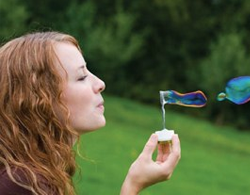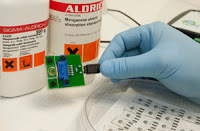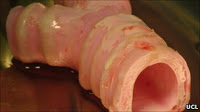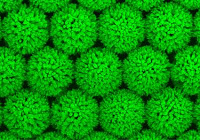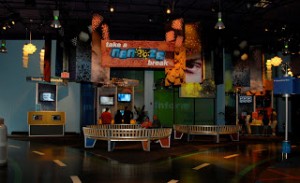Nanooze Blog
Keeping the World Safe
 Scientists at Cornell University have developed a suitcase sized detector for anthrax. Work done by Nate Cady who is now a professor at University of Albany began almost seven years ago when he first set out to make a lab on a chip that could extract DNA and then inspect it for different kinds of deadly bugs. That chip was less than a postage stamp in size. From there it was a matter of getting all the other stuff into a suitcase that you might be able to lug around to detect anthrax (or Salmonella or anything). The biggest pain was making pumps that could move around liquids. “while we are really good at making nanometer-scale electronics, we aren’t so good at making things to pump liquids”.
Scientists at Cornell University have developed a suitcase sized detector for anthrax. Work done by Nate Cady who is now a professor at University of Albany began almost seven years ago when he first set out to make a lab on a chip that could extract DNA and then inspect it for different kinds of deadly bugs. That chip was less than a postage stamp in size. From there it was a matter of getting all the other stuff into a suitcase that you might be able to lug around to detect anthrax (or Salmonella or anything). The biggest pain was making pumps that could move around liquids. “while we are really good at making nanometer-scale electronics, we aren’t so good at making things to pump liquids”.
Makes Sense to Me
Sensors, sensors everywhere and not a drop to drink. So what good is a really rapid sensor if you have send the sample to the laboratory to be tested. Researchers at the University of Cincinnati have developed a sensor to detect heavy metals in humans. Why? well heavy metals are found in the soil and other places and sometimes they find their way into your bodies. This is a special problem in young kids where heavy metals can cause all sorts of problems. The sensor works with just a small drop of blood and a set of electrodes. The metal is bound to the sensor and then stripped off by changing the voltage. It is kind of like the way we electroplate metals on to different things like car bumpers only on a nanometer-scale
Do Not Smoke !!!!
Well that is the most important thing. Smoking kills. But if you are shopping for a new windpipe nanotechnology has the answer. Doctors at University College London have developed a synthetic nanometer-scale material that can be fashioned into a windpipe. Not to be content with making another piece of synthetic tubing, it was transplanted into a patient in Sweden. First doctors took a 3D scans of the patient’s windpipe and used that to create a new artificial one. The nanomaterial was designed to attract cells that were taken from the patient’s bone marrow. Then the whole thing was reinserted into back into the patient. As of about a month ago the patient was doing well returning to his home country of Eritrea. To be honest I don’t know what the cause of his cancer was, but still do not smoke.
Nano Money
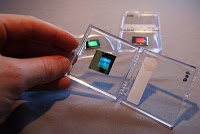 Gucci pocketbooks, Rolex watches and banknotes. What do they all have in common? They have value and there are a lot of fake ones around. In the US over the past couple of years, there are new banknotes that have things in them to reduce the problems of counterfeiting. Now some scientists at Simon Fraser University in Canada are trying to use nanotechnology to prevent bad guys from counterfeiting money. Their inspiration is the blue morpho butterfly which has a cool iridescent blue color. The color is produced when light reflects off the surface—a surface that has nanoscale features which diffract only a narrow spectrum of light. No color pigment that can be copied but only features that can be fabricated into the banknote. Some day these things to prevent counterfeiters could be used in a lot of different kinds of objects.
Gucci pocketbooks, Rolex watches and banknotes. What do they all have in common? They have value and there are a lot of fake ones around. In the US over the past couple of years, there are new banknotes that have things in them to reduce the problems of counterfeiting. Now some scientists at Simon Fraser University in Canada are trying to use nanotechnology to prevent bad guys from counterfeiting money. Their inspiration is the blue morpho butterfly which has a cool iridescent blue color. The color is produced when light reflects off the surface—a surface that has nanoscale features which diffract only a narrow spectrum of light. No color pigment that can be copied but only features that can be fabricated into the banknote. Some day these things to prevent counterfeiters could be used in a lot of different kinds of objects.
Start Your Engines
 The impact of nanotechnology on all parts of our lives is growing. And people are worried about how things might change. There are all sorts of rules for things like professional cycling and automobile racing. Mostly stuff like what you can make bicycles and race cares out of. Weight is really important because the less something weighs the easier it is to move around. So it isn’t surprising that lots of meetings will be held to talk about this. One at Cranfield University will focus on what race cars are made of and how that might important for the rules about racing. Carbon nanotubes are strong and lightweight. So putting them into all sorts of stuff like the chasis of a car can help make race cars faster. But along the way many are interested in making sure there are rules to keep them safe.
The impact of nanotechnology on all parts of our lives is growing. And people are worried about how things might change. There are all sorts of rules for things like professional cycling and automobile racing. Mostly stuff like what you can make bicycles and race cares out of. Weight is really important because the less something weighs the easier it is to move around. So it isn’t surprising that lots of meetings will be held to talk about this. One at Cranfield University will focus on what race cars are made of and how that might important for the rules about racing. Carbon nanotubes are strong and lightweight. So putting them into all sorts of stuff like the chasis of a car can help make race cars faster. But along the way many are interested in making sure there are rules to keep them safe.
Just like Mother Nature
Sometimes the answer lies with a very simple observation. In this case scientists in Switzerland have looked for solar cell designs by peering into the oceans. Sea urchins have a a very high surface area because they are rough. If you look closely the roughness is a very regular structure that is repeating. Using sea urchins as a design these scientists made similar structures from polystyrene and used them to mold nanowires. The array of wires are able to efficiently absorb sunlight more efficiently.
http://www.empa.ch/
Don’t Blow Your Gasket
 But if you do, there is a product to fix that. The people at CRC who make a lot of different products to fix your car have a new product to fix gaskets. Normally if you blow a gasket in a car engine you have to take everything apart and replace the gasket. This stuff apparently eliminates that problem “Using Nanotechnology, this product fills in cracks and crevices other products can’t, making a stronger, more solid bond that’s permanently hardened to the surface area.” Nanooze hasn’t tried this but hey nanotechnology saves the day (again).http://tinyurl.com/nanogasket
But if you do, there is a product to fix that. The people at CRC who make a lot of different products to fix your car have a new product to fix gaskets. Normally if you blow a gasket in a car engine you have to take everything apart and replace the gasket. This stuff apparently eliminates that problem “Using Nanotechnology, this product fills in cracks and crevices other products can’t, making a stronger, more solid bond that’s permanently hardened to the surface area.” Nanooze hasn’t tried this but hey nanotechnology saves the day (again).http://tinyurl.com/nanogasket
Forget About the TV, Remote Control the Worm
 Every want to have a little critter that you could direct like a remote control car? Scientists at the University of Buffalo have put tiny nanoparticles into the worm Caenorhabditis elegans (C. elegans because nobody wants to pronounce “Caenorhabditis”). These particles can heat up different parts of the worm and cause them to recoil. The localized heating opens channels that permit calcium to flow into the cells and that causes the worms to react.
Every want to have a little critter that you could direct like a remote control car? Scientists at the University of Buffalo have put tiny nanoparticles into the worm Caenorhabditis elegans (C. elegans because nobody wants to pronounce “Caenorhabditis”). These particles can heat up different parts of the worm and cause them to recoil. The localized heating opens channels that permit calcium to flow into the cells and that causes the worms to react.
How Smart Are Your Drawers?
 Smart phones, smart refrigerators, how about smart underwear? Researchers at University of California-San Diego have been making boxer shorts with tiny sensors that can measure biomarkers that are found in sweat. Biomarkers like glucose, lactic acid are all important things to measure. The sensors are made of tiny flexible electrodes that are tucked under the waist band and they can measure stress or performance levels. This is important for athletes or soldiers or perhaps even you?. The researchers are working with their colleagues at Clarkson University, no word if they are available in colors or just plain white.
Smart phones, smart refrigerators, how about smart underwear? Researchers at University of California-San Diego have been making boxer shorts with tiny sensors that can measure biomarkers that are found in sweat. Biomarkers like glucose, lactic acid are all important things to measure. The sensors are made of tiny flexible electrodes that are tucked under the waist band and they can measure stress or performance levels. This is important for athletes or soldiers or perhaps even you?. The researchers are working with their colleagues at Clarkson University, no word if they are available in colors or just plain white.
for more info http://tinyurl.com/smartshorts
Nano tattoo
Scientists at MIT have developed a tattoo that can measure the amount of sugar in your blood. Read more about it in the upcoming issue of Nanooze due out in July 2010.
Calling Nemo
 Communicating underwater is tough since sound waves travel differently in water than in air. Researchers at the University of Texas at Dallas have discovered that sheets of carbon nanotubes can act as speakers 100x more effectively than they predicted. The carbon nanotubes are very hydrophobic (meaning they don’t like water) so there is a very thin layer of air which helps transmit sound. Maybe in the future you can call up a fish for dinner.
Communicating underwater is tough since sound waves travel differently in water than in air. Researchers at the University of Texas at Dallas have discovered that sheets of carbon nanotubes can act as speakers 100x more effectively than they predicted. The carbon nanotubes are very hydrophobic (meaning they don’t like water) so there is a very thin layer of air which helps transmit sound. Maybe in the future you can call up a fish for dinner.
for more information
It’s Different Up There
 So nano is different but so is space. Space or more likely microgravity changes a lot of things in addition to drinking and eating and walking around. Scientists have done a lot of experiments in space looking at how cells behave. With more sophisticated tools to study the molecular changes scientists are now discovering just how different things in space are for terrestrial biology. The latest work is using stem cells, those interesting cells in your body that have the ability to form different tissues and bone. They are really important for a lot of therapies to cure diseases such as cancer, diabetes and other stuff. Taking a bit of mouse stem cells into space, scientists discovered that about 64% of the proteins that these cells made in space weren’t there when the same cells were grown on the Earth. That is a nanometer kind of change since most proteins are a few nanometers across. Stem cells are around 10,000 nanometers in size. One of the scientists, Elizabeth Blaber talked about this work in Houston, Texas at the astrobiology conference. She is a young scientist at the University of New South Wales in Australia working in a field she calls bioastronautics. Going from Australia to Texas (about 14 trillion nanometers) isn’t quite like going into space but a neat opportunity for a young scientist.
So nano is different but so is space. Space or more likely microgravity changes a lot of things in addition to drinking and eating and walking around. Scientists have done a lot of experiments in space looking at how cells behave. With more sophisticated tools to study the molecular changes scientists are now discovering just how different things in space are for terrestrial biology. The latest work is using stem cells, those interesting cells in your body that have the ability to form different tissues and bone. They are really important for a lot of therapies to cure diseases such as cancer, diabetes and other stuff. Taking a bit of mouse stem cells into space, scientists discovered that about 64% of the proteins that these cells made in space weren’t there when the same cells were grown on the Earth. That is a nanometer kind of change since most proteins are a few nanometers across. Stem cells are around 10,000 nanometers in size. One of the scientists, Elizabeth Blaber talked about this work in Houston, Texas at the astrobiology conference. She is a young scientist at the University of New South Wales in Australia working in a field she calls bioastronautics. Going from Australia to Texas (about 14 trillion nanometers) isn’t quite like going into space but a neat opportunity for a young scientist.
Ouch
 Getting a shot, a vaccination or something that your doctor uses a needle to give you can hurt. But does it have to hurt? Maybe not according to scientists in Australia. For a few years now they have been working on something they call the nanopatch. It has a lot of very small projections (like needles) that help to deliver the vaccine to a special group of cells that helps you develop immunity. These tiny projections are coated with the vaccine and the patch is applied to your skin. So far they have tested it on mice but sometime in the near future they should be testing it on humans. It takes a lot of time for any kind of new medicine or device to be approved for use in humans. That is because there is a lot of safety testing that needs to happen and then proof that it really does work. It is sometimes frustrating because a great discovery in the lab takes a few years to make it into the clinic. Even nanotechnology can’t make that happen any faster.
Getting a shot, a vaccination or something that your doctor uses a needle to give you can hurt. But does it have to hurt? Maybe not according to scientists in Australia. For a few years now they have been working on something they call the nanopatch. It has a lot of very small projections (like needles) that help to deliver the vaccine to a special group of cells that helps you develop immunity. These tiny projections are coated with the vaccine and the patch is applied to your skin. So far they have tested it on mice but sometime in the near future they should be testing it on humans. It takes a lot of time for any kind of new medicine or device to be approved for use in humans. That is because there is a lot of safety testing that needs to happen and then proof that it really does work. It is sometimes frustrating because a great discovery in the lab takes a few years to make it into the clinic. Even nanotechnology can’t make that happen any faster.
http://tinyurl.com/nanopatch
Sensing Things Around Us
 For a while there has been talk about distributed sensors. Planting tiny sensors all around to get an idea about what might be going on. Going on with the Earth, maybe predicting earthquakes and things like that. Why distributed? Because this way you don’t take a chance on planing one sensor and then picking the wrong spot. HP has taken a step toward distributed sensing by developing the CeNSE network and they are using it to help find oil. These tiny microelectromechanical sensors (MEMS) can detect vibrations. Now they are pretty big but someday scientists hope to make them the size of a pin head. If you install a few million or billion you can get an idea of what is going on over a large area. The challenge is powering them and then collecting all of the data. But someday they will be installed in everything like buildings, bridges, roads and tell us all about how these things are doing and sensing lots of different things.
For a while there has been talk about distributed sensors. Planting tiny sensors all around to get an idea about what might be going on. Going on with the Earth, maybe predicting earthquakes and things like that. Why distributed? Because this way you don’t take a chance on planing one sensor and then picking the wrong spot. HP has taken a step toward distributed sensing by developing the CeNSE network and they are using it to help find oil. These tiny microelectromechanical sensors (MEMS) can detect vibrations. Now they are pretty big but someday scientists hope to make them the size of a pin head. If you install a few million or billion you can get an idea of what is going on over a large area. The challenge is powering them and then collecting all of the data. But someday they will be installed in everything like buildings, bridges, roads and tell us all about how these things are doing and sensing lots of different things.
Seeing is Believing
 It was more than 50 years ago that scientists first figured out that DNA was a double helix. Figured out using some indirect measurements like the way X-rays bounced off of DNA and other things like that. Can we see DNA? Sure now with some pretty powerful microscopes. And just recently some scientists in Japan took a look at double stranded DNA and could tell the difference between that and single stranded DNA. The work could have a big impact on things like DNA sequencing.
It was more than 50 years ago that scientists first figured out that DNA was a double helix. Figured out using some indirect measurements like the way X-rays bounced off of DNA and other things like that. Can we see DNA? Sure now with some pretty powerful microscopes. And just recently some scientists in Japan took a look at double stranded DNA and could tell the difference between that and single stranded DNA. The work could have a big impact on things like DNA sequencing.
To learn more go to:
http://tinyurl.com/DNAview
Build your own (not so nano but fun) bot
 Everyone wants to be an evil scientist and create their own little nanobot. Well that is hard but building something cool and entertaining with a few parts isn’t. The bristle bot is a self-propelled little thing that scoots along the floor. It isn’t hard to build and you can find the parts in a lot of different places. The motor is the same one that you find in a cell phone that can vibrate (we don’t recommend tearing into a cell phone, especially one that works). This activity was developed by Windell Oskay at Evil Mad Scientist. Check him out. http://www.evilmadscientist.com/article.php?story=bristlebot
Everyone wants to be an evil scientist and create their own little nanobot. Well that is hard but building something cool and entertaining with a few parts isn’t. The bristle bot is a self-propelled little thing that scoots along the floor. It isn’t hard to build and you can find the parts in a lot of different places. The motor is the same one that you find in a cell phone that can vibrate (we don’t recommend tearing into a cell phone, especially one that works). This activity was developed by Windell Oskay at Evil Mad Scientist. Check him out. http://www.evilmadscientist.com/article.php?story=bristlebot
One hair at a time
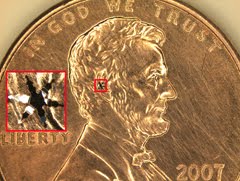 Little machines, so small they can enter your body and zoom around fixing stuff. The great scifi classic ‘Fantastic Voyage’ was all about that, shrinking not just a space ship but all of the folks inside and then zooming around the blood stream. While that will never happen, building tools so small that they can work inside the body without cutting big holes in you is an important area. Scientists are building all sorts of devices that will hold and cut and mend small parts in your body. The big challenge is building them and then powering them. One way to provide power is to use polymers that respond to heating or some external chemicals. The polymer changes its shape and causes the parts that the polymer is attached to—in this case the arms of a gripper—to close. These tiny grippers might be used to grab cancer cells and then bring back samples for analysis. For more information: http://tinyurl.com/tinycutters
Little machines, so small they can enter your body and zoom around fixing stuff. The great scifi classic ‘Fantastic Voyage’ was all about that, shrinking not just a space ship but all of the folks inside and then zooming around the blood stream. While that will never happen, building tools so small that they can work inside the body without cutting big holes in you is an important area. Scientists are building all sorts of devices that will hold and cut and mend small parts in your body. The big challenge is building them and then powering them. One way to provide power is to use polymers that respond to heating or some external chemicals. The polymer changes its shape and causes the parts that the polymer is attached to—in this case the arms of a gripper—to close. These tiny grippers might be used to grab cancer cells and then bring back samples for analysis. For more information: http://tinyurl.com/tinycutters
Keeping ’em Honest
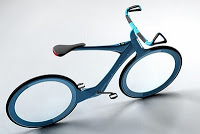 A warning from the International Cycling Union, no nanotech at the Olympic games in London 2012. “At London in 2012 we can guarantee there will be no-one using bikes, equipment and not even clothing (that is illegal) – because we are aware of developments in nanotechnology that can aid athletes in ways that would be outside the rules.” said Pat McQuaid, chief of the UCI. Maybe we need to sponsor a nanotech olympics and give out nano gold medals.
A warning from the International Cycling Union, no nanotech at the Olympic games in London 2012. “At London in 2012 we can guarantee there will be no-one using bikes, equipment and not even clothing (that is illegal) – because we are aware of developments in nanotechnology that can aid athletes in ways that would be outside the rules.” said Pat McQuaid, chief of the UCI. Maybe we need to sponsor a nanotech olympics and give out nano gold medals.
http://tinyurl.com/olympicnano
Power Up While You Boggie
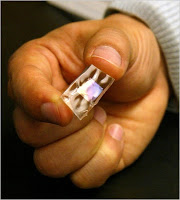 It takes energy to move. Move to the kitchen, to school, to the couch. And there is a lot of energy that can be captured from these movements. Maybe you have a pair of those sneakers with the lights? They capture the energy from walking and uses it to power a few tiny light bulbs. Now scientists are trying to take it to the next level by developing more sophisticated nanodevices and make them cheaper. They use these things called piezoelectric crystals. Piezoelectric things have been around since the mid-18th century but these new ones are printed and they can be printed onto flexible materials that are also biocompatible. So maybe you don’t want them stitched to the bottom of your feet but perhaps they can be stuck onto a lot of different things making energy for all sorts of devices. No more need to change the battery unless you become a couch potato.
It takes energy to move. Move to the kitchen, to school, to the couch. And there is a lot of energy that can be captured from these movements. Maybe you have a pair of those sneakers with the lights? They capture the energy from walking and uses it to power a few tiny light bulbs. Now scientists are trying to take it to the next level by developing more sophisticated nanodevices and make them cheaper. They use these things called piezoelectric crystals. Piezoelectric things have been around since the mid-18th century but these new ones are printed and they can be printed onto flexible materials that are also biocompatible. So maybe you don’t want them stitched to the bottom of your feet but perhaps they can be stuck onto a lot of different things making energy for all sorts of devices. No more need to change the battery unless you become a couch potato.
http://tinyurl.com/ygbr3g3
read about the original science http://pubs.acs.org/doi/abs/10.1021/nl903377u
Nanooze the Exhibit opens at EPCOT, Walt Disney World
So it started as a web site, next a magazine and now an exhibit. On February 22, 2010 , ‘Take a Nanooze Break’ opened at EPCOT Walt Disney World in Florida. The interactive exhibit has a number of opportunities for guests to explore the nanoworld and get a feel for things that are too small to see. The exhibit is on long term display located in Innoventions where new science and technology is showcased. You can sit and listen to stories about nanotechnology, play with a simple to use hand-held microscope, take molecules for a spin and zoom into the nanometer scale structure of a number of different common objects.

